How to Plan a Fundraising Event: 13 Steps to Raise More
Nonprofits like yours depend on consistent revenue to make a lasting impact, serve your beneficiaries, and drive your mission forward. One of the best ways to generate support? Hosting a fundraising event that connects and energizes your community!
But let’s face it: planning a fundraising event is no small feat. From crafting a compelling marketing campaign to using the right fundraising technology to seamlessly manage registrations and communications, there are plenty of moving parts to juggle.
That’s why we’ve created this guide to take the guesswork out of event planning. With these 13 steps, you’ll have a roadmap to plan a fundraising event that doesn’t just meet your goals – it exceeds them.
Here’s what we’ll cover:
- Determine your fundraising event goals.
- Pick the right type of event fundraiser.
- Set a realistic fundraising event budget.
- Choose your fundraising software.
- Build a dedicated fundraising event planning committee.
- Partner with corporate sponsors.
- Recruit loyal volunteers.
- Lock in a date and time for your fundraising event.
- Spread the word about your fundraising event with strategic marketing.
- Sell tickets to your fundraising event.
- Get everything ready for the big day.
- Enjoy your fundraising event!
- Follow up with attendees after your event to keep the momentum going.
By rallying your team around these action steps, you’ll be on your way to hosting a great event that goes off without a hitch.
1. Determine your fundraising event goals.
To host a successful event, you need to define what success looks like for your organization. Start by setting strategic goals using the SMART framework (Specific, Measurable, Attainable, Relevant, and Time-bound). This gives your team a clear path to follow and a way to track progress.
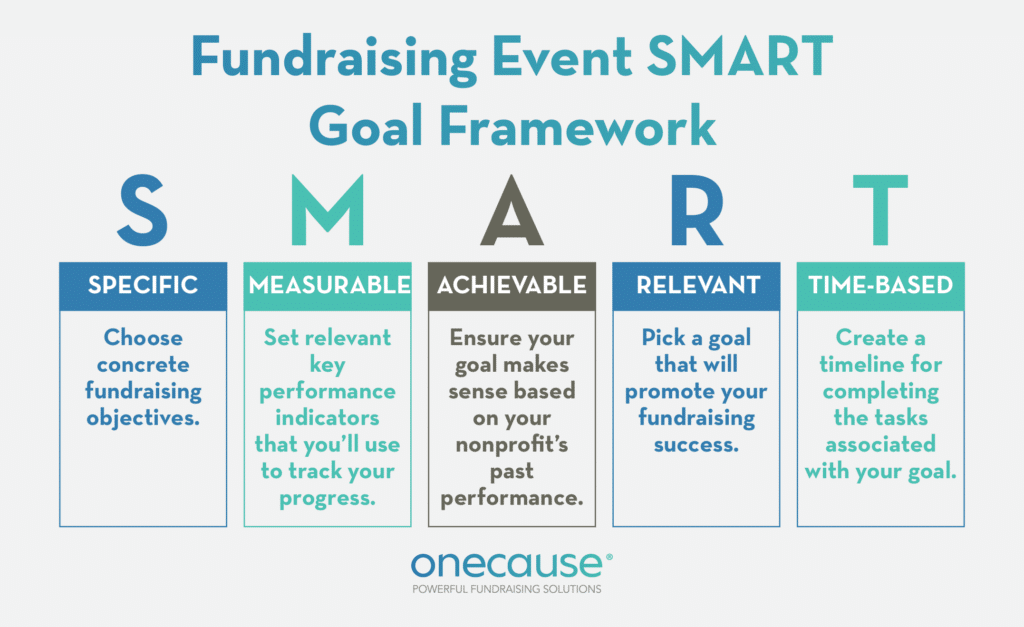
Let’s bring the SMART framework to life with an example of a nonprofit planning a peer-to-peer walkathon:
- Specific: We’ll aim to raise $15,000 during our annual walkathon, with all proceeds supporting our mission to find a cure for breast cancer.
- Measurable: We’ll use our fundraising technology to track donations, identifying new vs. returning donors to inform our acquisition and retention strategies.
- Achievable: Last year, we raised $10,000. We’ll elevate our gamification strategy and get our board members involved in ambassador fundraising, so our goal to increase the amount raised by $5,000 is doable.
- Relevant: The funds will directly support our mission to advance research and treatment options for breast cancer patients in our community.
- Time-bound: We’ll launch the peer-to-peer campaign for our walkathon one month before the event, ending at midnight on the day of the walkathon. Each week, we’ll check in on our fundraising progress and adjust our strategy as needed.
In addition to establishing a clear revenue goal, your nonprofit should also consider setting awareness and engagement objectives, including:
- Acquiring new donors
- Promoting your cause or gaining publicity
- Stewarding existing donors
- Engaging prospective major donors
- Reconnecting with lapsed supporters
- Recognizing volunteers or recurring donors
- Earning a certain number of impressions or likes on your event-related social media content
As you plan your goals, assign clear roles to team members. For example, have your marketing team handle your content calendar and launch an engaging social media campaign. When everyone knows their part, motivation stays high and your goals become achievable.
2. Pick the right type of event fundraiser.
With your goals set, it’s time to choose an event that resonates with your audience. The better the match, the greater the turnout and impact!
Look to your donor database to get a picture of the kind of event your supporters would most gravitate towards. Ask yourself the following questions to point your nonprofit’s team in the right direction:
- What past events or fundraisers have received our donors’ most enthusiastic participation and support? Popular events offer clues about donor preferences.
- How do your supporters prefer to get involved? For example, if plenty of your supporters also volunteer, you might plan an event with a community service component. If your cause is health-related and your supporters are passionate about physical fitness, a run/walk/ride event is ideal. Think through what gets your supporters the most excited to participate in your cause.
- Where do your donors live? If your supporters are spread across the country, a virtual or hybrid event broadens your reach and ensures accessibility for all. For instance, you might host a hybrid auction where your local VIP supporters are invited to participate in person and the rest of your community can join online.
- Will the weather impact your event? An outdoor fundraising event might draw in more attendees in the spring or summer. An indoor charity gala, on the other hand, can be hosted year-round.
- Does your cause have a specific demographic? If you’re raising money for a school, for example, an all-ages fundraising event such as a family-friendly cookout or field day may be more successful than a parents-only evening event.
- What feedback or suggestions have our donors provided regarding fundraising events or initiatives? Go right to the source to find out the types of events that get your community the most amped up.
Your fundraising goals should also heavily inform the kind of event you host. For example, if your goal is to expand your network of donors, you might host an auction with a peer-to-peer component to attract new supporters and form stronger connections with your fundraisers.
Alternatively, let’s say your organization is hoping to raise awareness about a specific issue in your community while also raising funds to support related initiatives. In this case, you might consider hosting a themed fundraising gala or benefit dinner. This fundraising event can include live presentations, keynote speakers, and an auction component to spark giving.
Once you’ve decided, pick a venue that suits your event’s needs—like a stage for performances or flexible spaces for auctions.
Need fundraising inspiration? Check out our list of amazing fundraising event ideas to find an event that aligns perfectly with your audience and goals.
3. Set a realistic fundraising event budget.
While fundraising events can be lucrative, you’ll have to invest some of your own capital to make the event happen. Crafting a detailed budget helps you stay on top of costs and avoid surprises.
While every event is different, some common costs include:
- Event fundraising software: Invest in tools that simplify event management and enhance guest experiences. In the next section, we’ll cover how to choose the right provider that will provide value for years to come.
- Space-related costs: Consider how much money you can allocate toward a venue. Remember, you don’t need a lavish ballroom! Most fundraising events can be readily adapted to work in spaces you already have access to.
- Event perks: Expenses like entertainment and catering can add up! Look for ways to offset costs, such as leaning on sponsors or asking volunteers for extra support.
- Technology: From sound systems to projectors, ensure you’ve accounted for essential equipment. Your venue should be able to provide a list of equipment they have on hand.
- Promotional items: Branded merchandise can be great incentives to increase attendance or participation.
Make a spreadsheet with all the items you’ll need and do some research to find the average prices for your budget items. You’ll also want to add some padding to your budget for any unexpected costs.
4. Choose your fundraising software.
The right event fundraising software will make planning your fundraiser a breeze. Look for a comprehensive event fundraising solution that offers all the features you need to pull off a successful event, including:
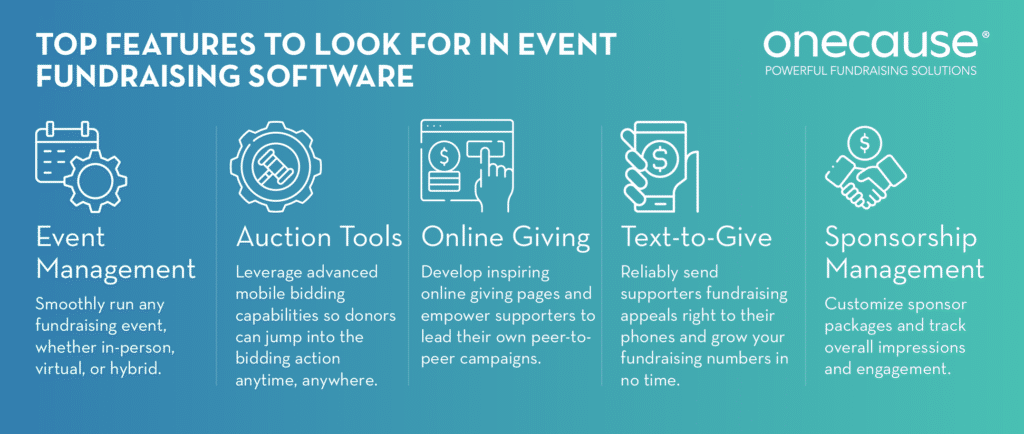
Event Management
Whether you’re hoping to host an event in-person, online, or as a hybrid combination of the two, your fundraising software should make it simple to run events of all types year-round. Specifically, your software should empower your nonprofit to seamlessly sell custom ticket packages and manage RSVPs, offer contactless check-in and check-out, create table groups and oversee seating, and leverage real-time analytics to enhance your strategy.
Auction Tools
Thinking of hosting an auction? With mobile bidding tools, you can create a streamlined way for your guests to submit bids right from their smartphones. Look for software that also allows your participants to set maximum bids, buy fixed-priced items, and receive automated outbid notifications.
Online Giving
With 69% of donors reporting that ease of giving is the most important factor when it comes to attending an event, you must create a positive online donation experience. Using your fundraising tools, you should be able to create mobile-friendly donation pages branded to your organization, develop engaging fundraising microsites to inspire audiences and drive conversions, and use secure SSL/PCI processing to safeguard your donors’ personal information. Plus, your supporters should be able to easily create their own personal fundraising pages.
Text-to-Give
Want to take your fundraising to the next level? Incorporate text-to-give into your next nonprofit event! This is a great way to bring in extra donations in a way that is easy and convenient for donors. Supporters simply opt into your texts using your keyword and short-code and are sent a mobile-friendly link to your donation page.
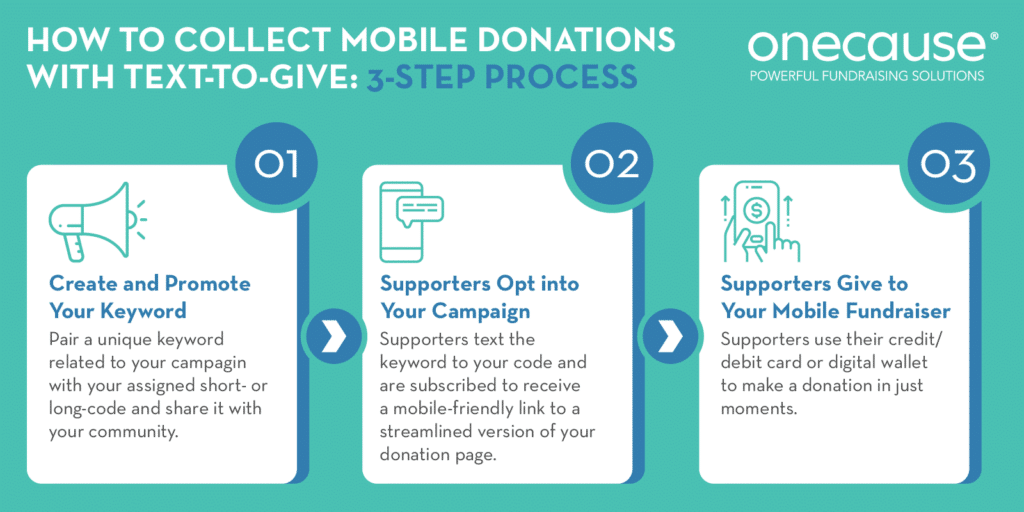
The right fundraising software will support your text-to-give efforts by empowering your nonprofit to send compelling calls to action, display fundraising progress with an interactive scoreboard, and seamlessly manage campaigns.
Sponsor Management
Managing your corporate sponsorships shouldn’t be a hassle! Work with event fundraising software that allows your nonprofit to create customizable online sponsor packages and group and size your sponsors’ logos based on contribution level. Plus, you should be able to readily track impressions and engagement to show your sponsors the value of partnering with your organization.
5. Form a committee for fundraising event planning.
As mentioned previously in the goal-setting section, you must identify the people in charge of seeing each of your goals through. Form a fundraising event planning committee that will be tasked with tackling specific aspects, such as:
- Venue/Catering
- Sponsorships
- Marketing and promotions
- Ticket sales or registration
- Volunteer management
- Major donor involvement
- Venue setup
- Auction item procurement
- Event follow-up
Specifying who oversees the projects associated with your goals will minimize the risk of miscommunication and ensure everyone knows their role in fueling the success of your event.
6. Partner with corporate sponsors.
Sponsorships provide nonprofit organizations with additional revenue they can put toward making their event a memorable and enjoyable experience for attendees. For example, you can ask corporate sponsors to provide:
- Financial support, such as financing the cost of catering or matching all gifts made to your cause during the event.
- In-kind donations, like offering their office space for your event venue or donating items that can be used for your auction.
- Skilled volunteers, such as professional graphic designers who can support your marketing strategy.
Here are a few tips for forming successful corporate partnerships:
- Identify key potential sponsors: Tap board members, volunteers, and major donors for connections to corporations. From there, identify businesses that share a similar mission or values to your organization. This creates a natural connection and makes the sponsorship more appealing.
- Create sponsorship packages and tiers: Develop tiers with varying benefits, such as logo placement, speaking opportunities, or digital promotions. Don’t be afraid to get creative! Include unique perks, such as naming rights for parts of the event, product placement opportunities, or exclusive networking access.
- Develop a clear sponsorship proposal: Explain your nonprofit’s mission and the event’s purpose. Then, detail what the sponsor will receive in exchange for their support, including brand exposure and opportunities to engage with a desirable audience.
- Demonstrate the value you offer: Include statistics or testimonials demonstrating the success of past events and the impact of sponsorship on similar companies/organizations.
Tailor your proposal to each potential sponsor and the perks they’d be most interested in. For example, if a sponsor is interested in reaching out to a younger audience, highlight the key demographics of your nonprofit’s audience and prominently display the percentage of your supporters who are members of Gen Z.
7. Recruit loyal volunteers.
Planning a fundraiser is a team effort; sometimes your nonprofit’s staff alone aren’t enough to cover all the bases. That’s where your incredible volunteers come in! They can help you with essential tasks, such as:
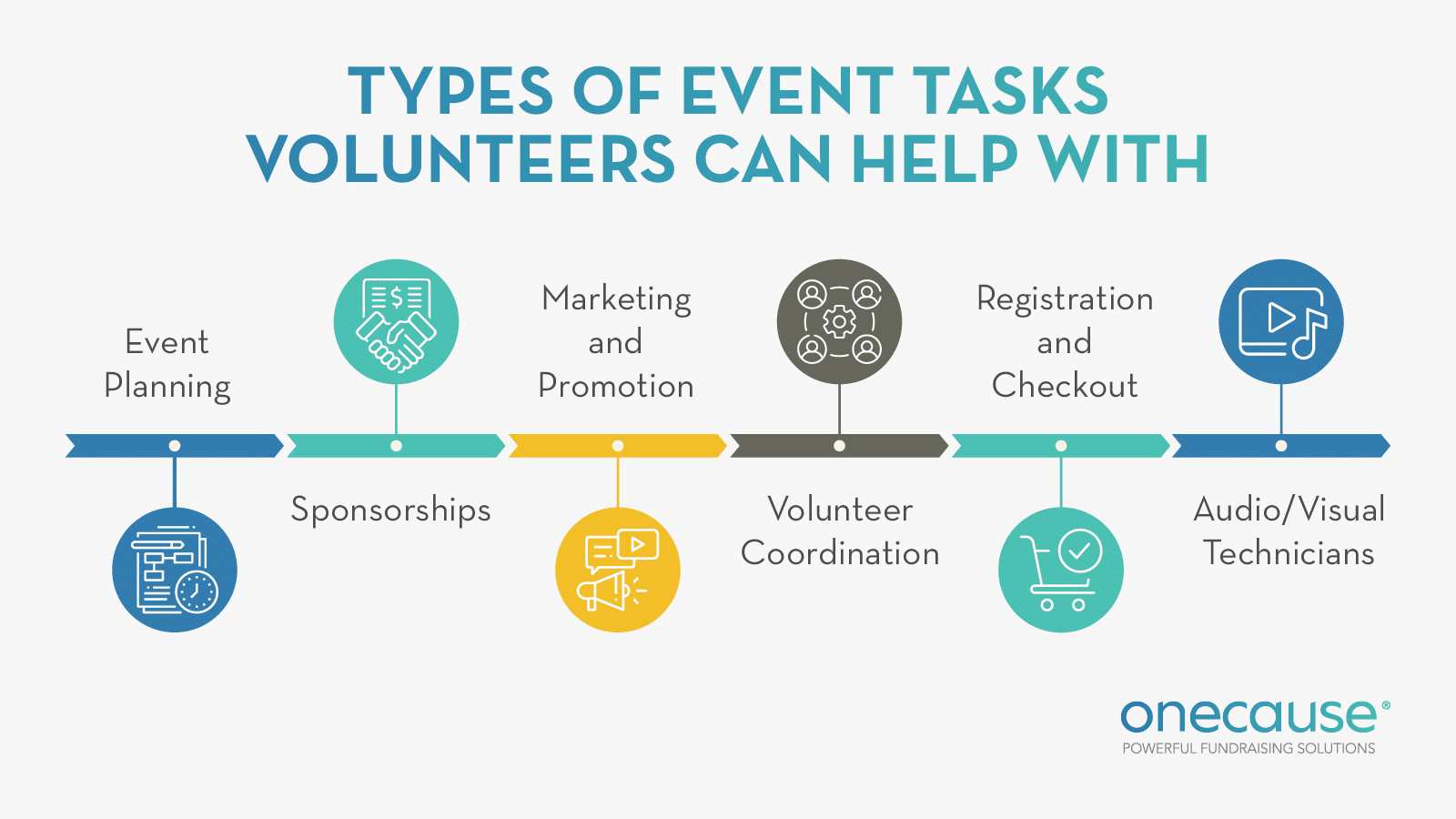
- Event Planning: Book venues, create or arrange schedules, and secure necessary permits to keep the event on track.
- Sponsorships: Build and manage relationships with corporate sponsors, ensuring they receive the benefits of their partnership.
- Marketing and Promotion: Help design and distribute promotional materials, manage social media, and generate buzz in your community.
- Volunteer Coordination: Recruit, train, and schedule volunteers to ensure every role is covered and responsibilities are clear.
- Registration and Checkout: Greet attendees, check them in, distribute event materials, and assist with item pick-up and guest checkout.
- Audio/Visual Technicians: Ensure smooth operation of sound systems, projectors, and other technical equipment to keep things running smoothly.
Don’t forget to tap into the networks of well-connected supporters! These individuals can serve as ambassadors for your cause. Their wide networks can increase your reach and encourage others to attend or donate.
8. Set a date and time for your fundraising event.
One of the most important details to nail down early is when your event will take place! Before you can book entertainment or secure a venue, it’s essential to pick a time and date that works for your team and supporters. Keep the following questions in mind as you consult your calendar:
- Are we planning far enough ahead? Giving yourself enough lead time ensures you can secure your ideal venue, vendors, and entertainment. It also gives guests more time to RSVP.
- Is this an annual event? If your fundraiser happens every year, consistency is key. Hosting it around the same time each year helps supporters know when to expect it and plan accordingly.
- Does our fundraiser conflict with any other major events? Be mindful of holidays and other national or local events that might draw attention away from your fundraiser.
- Should our event be on a weeknight or weekend? If you’re hosting a daytime event, opt for a weekend when donors are more likely to be free. If your event takes place in the evening, you’ll likely find a better deal on a venue on a weeknight, but consider that guests may leave earlier.
For extra confidence in your decision, survey your supporters to find out when they’re most likely to attend an event. Not only does this show you value their input, but it also helps you choose a date and time that maximizes your fundraising event’s attendance and fundraising potential.
9. Spread the word about your fundraising event with strategic marketing.
You’ve started planning the details for your perfect event, but something is missing—your guests! To reach your constituents and guarantee a packed house, you’ll need a strong nonprofit marketing plan.
The most effective promotional plans use multiple communication channels to reach supporters where they are. Here are some tried and true ways to spread the word about your upcoming event:
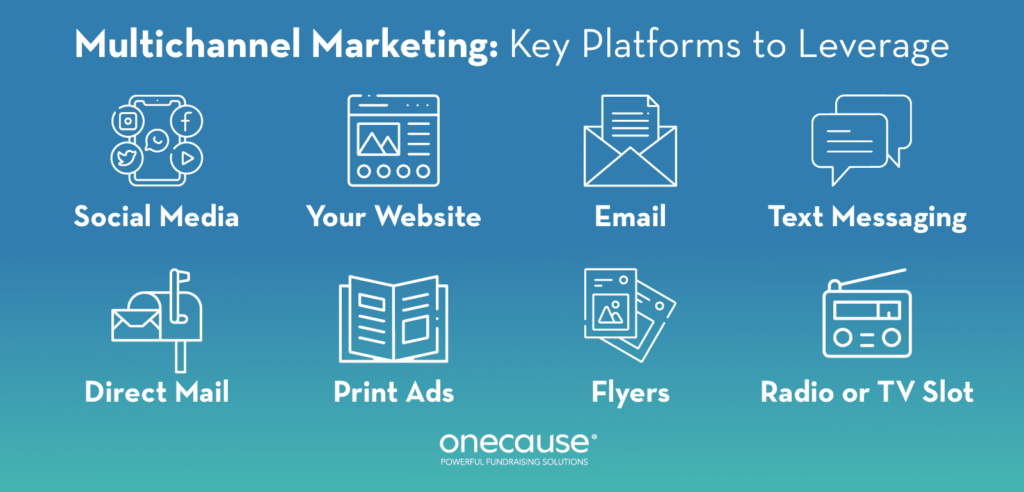
- Social media: Share eye-catching posts, graphics outlining your impact, and behind-the-scenes videos featuring your team.
- Your website: Build an engaging event landing page or microsite that explains your event’s purpose and how supporters can get involved.
- Email: Use newsletters and standalone promotional messages to highlight your event and invite attendees.
- Text messaging: Send concise texts that effectively create hype around your event.
- Direct mail (including invitations): Add a QR code to your mail so supporters can learn more about your event and register online.
- Flyers: Distribute well-designed fundraising flyers around your community if your event has a local focus.
- Print ads in local newspapers: Include all the logistical details of your event, including the name, purpose, fee for attendance if applicable, date, time, and location.
- Radio or TV spots: Feature one of your nonprofit’s leaders discussing why your event matters and why supporters should attend.
To maximize your marketing, prioritize sharing content on the channels your supporters use most often. By targeting the right people with the right advertisements on the right channels, you’ll increase the chances of a packed event.
Additionally, be strategic in your approach to each marketing channel. For example, once you develop a fundraising event site, you’ll also need a way to ensure your website appears in search engine results.
Want to amplify your event’s visibility? In addition to improving your search engine optimization using best practices like prioritizing accessibility and creating quality content, Google Ad Grants offers eligible nonprofits $10,000 in free ad credits per month. This allows organizations like yours to bid on keywords and promote specific event-related pages on your site.
For instance:
- A nonprofit hosting a fundraising gala for ocean conservation might target the keyword “ocean conservation gala,” ensuring their event registration page appears at the top of search results.
- You can even use Google ads to market open volunteer roles for your event. An animal shelter hosting an event could use ads to recruit volunteers with a keyword like “animal shelter volunteering.”
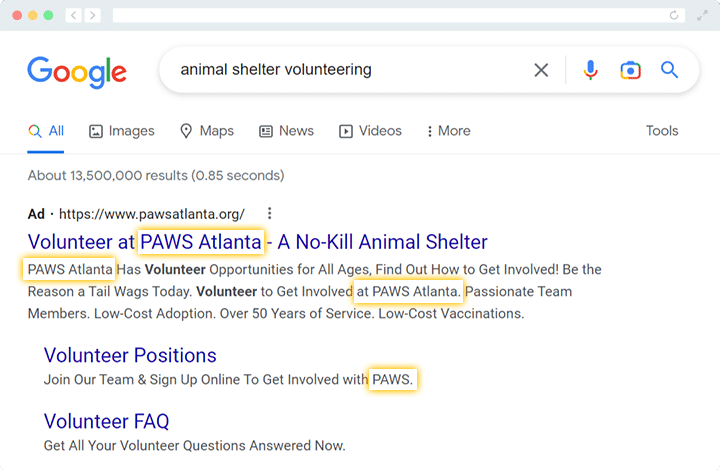
To optimize your Google Ad Grants strategy and maximize your advertising credits, keep these best practices in mind:
- Use specific long-tail keywords to attract the right audience.
- Ensure your ads link to the most relevant pages to create a positive user experience.
- Keep your landing pages professional, branded, and focused on clear calls to action.
Remember, you don’t need an extensive budget to see results! Leveraging free tools like Google Ad Grants can help your organization effectively promote its fundraising events without increasing expenses.
10. Sell tickets to your fundraising event.
Once your marketing is underway, it’s time to focus on ticket sales and/or registrations. Start selling tickets to your event as early as possible to give supporters ample time to secure their spots. As you prepare to launch ticket sales, consider these key points:
- Will you charge a flat price or offer different ticket packages? Think about creating tiered options to suit various budgets, such as VIP packages at a higher price or discounts for groups or families. You could also incentivize early purchases with discounted pricing for those who buy sooner.
- Where will you sell tickets? Make the ticket-purchase process simple by providing a clear, user-friendly option on your event fundraising site. Clearly lay out prices and packages to avoid confusion.
- How will you manage attendee information? With every ticket sold, you’ll collect valuable donor data. The best way to organize this information is by integrating your event fundraising software with your CRM. This ensures all attendee data flows seamlessly into your donor database, making it easier to track and follow up with supporters
Keep in mind that creating a simple, intuitive registration process makes all the difference for your attendees. Make sure you test the ticketing process from your own site as if you were a guest. By stepping into your guests’ shoes, you’ll weed out any issues or “gotchas” before you go live!
The right event fundraising software can take the hassle out of ticket sales. Look for a solution that empowers you to:
- Customize ticket packages, coupons, and discount codes.
- Offer seating preferences and manage table assignments.
- Enable optional donations at the time of ticket purchase.
To bring in even more donations, consider embedding a matching gift widget into your registration page so supporters can research their eligibility.
11. Get everything ready for the big day.
Your fundraising event is finally here! It’s time to put all your hard work into action and make the big day (or night) a memorable success. Before you open the doors, put all the final touches in place:
- Coordinate with Entertainment: Confirm when performers or speakers will arrive, where they should park, and the schedule for rehearsals or sound checks.
- Decorate the Venue: Add those finishing touches to create an inviting atmosphere that reflects your nonprofit’s mission and theme.
- Schedule and Organize Volunteers: Double-check that volunteers know their roles, schedules, and where to be during the event.
- Arrange Day-of Ticket Sales or Registration: Prepare for day-of ticket sales or check-ins to keep the entry process seamless.
- Place Auction Item Displays: Showcase auction items in a way that grabs attention and encourages bidding.
- Prepare Refreshments: Ensure food and beverages are ready to go and accessible for guests.
For larger or more complex events, a detailed plan of action is essential. Provide your team with clear instructions that outline:
- When and where to arrive
- Dress code expectations
- Assigned tasks and responsibilities
- Shift durations and break times
Share these details well in advance to give everyone plenty of time to ask questions or address any last-minute concerns.
Consider doing a practice run-through with your technology and volunteers. Test your AV equipment, practice using your registration or auction software, and rehearse transitions between activities. This preparation helps everyone feel confident and allows you to catch and resolve any potential issues ahead of time.
Remember: the more prep work you put in, the less you’ll have to worry about on the day of your fundraiser!
12. Enjoy your fundraising event!
When the big day arrives, it might be tempting to kick back and think, “My work here is done!” While you absolutely deserve to relax a little and soak in the moment, there are still a few ways to make the most of your event while it’s happening.
Here’s how to maximize your event for yourself and your supporters:
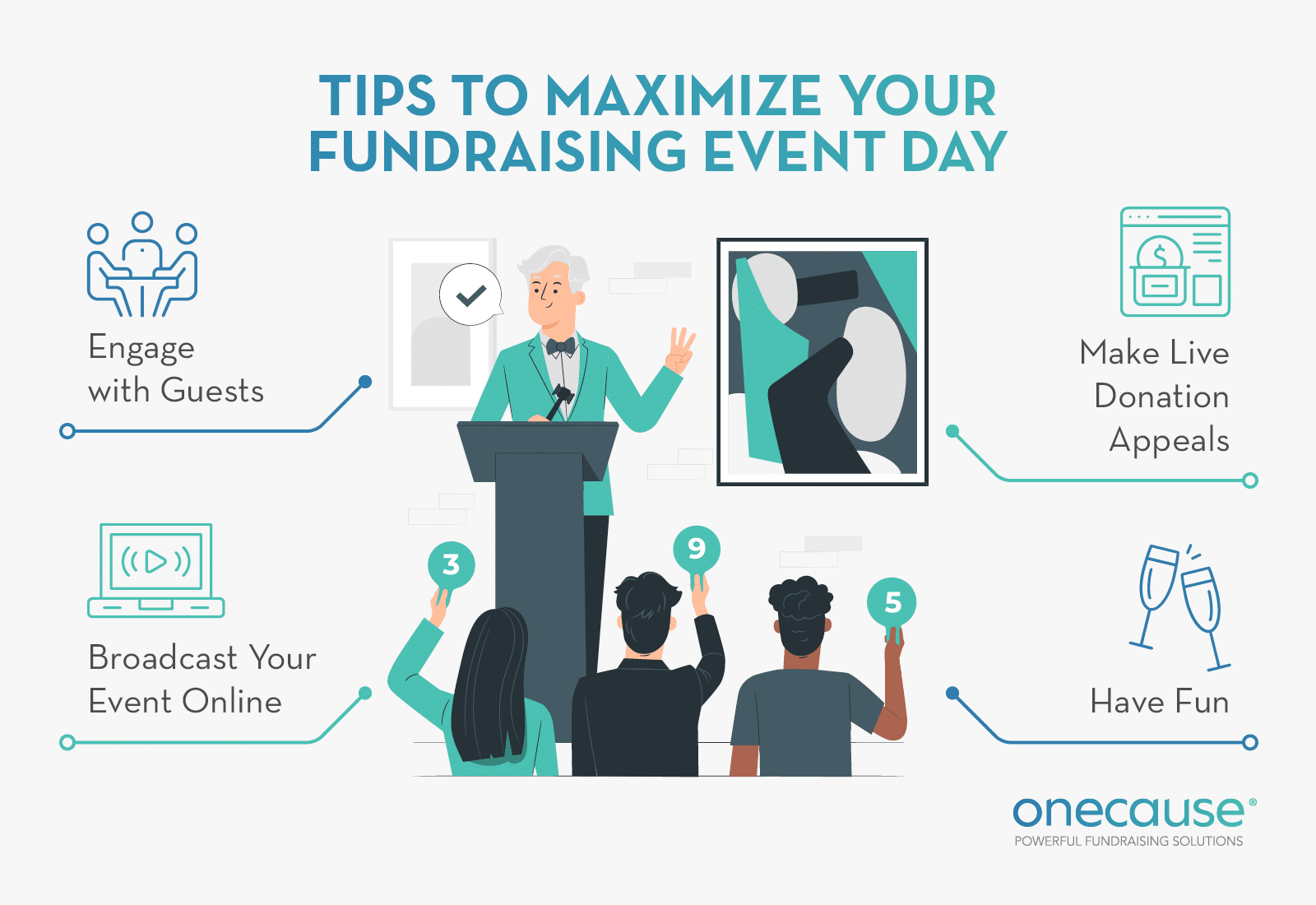
- Engage with guests: Use this time to connect with attendees and donors. Check in with them, thank them for coming, and make sure they’re having a great time! These personal interactions can leave a lasting impression.
- Broadcast your event online: For those who can’t attend in person, take the party online! Livestream your event using your online fundraising tools, complete with live chat capabilities. Create a social media hashtag so people can join the conversation and posts related to your event.
- Make live donation appeals: Tap into the energy of the vent by encouraging live donation. Whether through a fundraising thermometer display, text-to-give campaigns, or direct appeals, create opportunities for attendees to give the moment their enthusiasm is high.
- Have fun! Show your attendees how much you appreciate them by enjoying the event alongside them. Smile, mingle, and celebrate the success of your hard work with your guests.
If you notice a dip in engagement levels, ramp up your gamification strategy and add more interactive activities. For example, you might highlight the fundraising leaderboard to spark a little friendly competition or offer live polls and chat capabilities for remote supporters to keep them involved.
13. Follow up with attendees after your event.
Your event may be over, but your work isn’t done yet! The follow-up phase is one of the most important parts of your fundraiser. It’s your chance to strengthen relationships with supporters and keep them engaged with your mission.
Promptly send thank-you notes to everyone who was involved with your event, including sponsors, guests, and volunteers. You might send handwritten notes to the supporters who made a significant difference and share digital eCards with the rest of your attendees.
Don’t forget to let supporters know how their contributions made a difference. They’ll want to know how this fundraising event impacted your cause, so be as detailed as possible.
To get supporters’ feedback on your event, send a survey to all who attended. Consider including questions like:
- What aspects of the event were most successful, and where can we improve?
- How did you hear about the event?
- Was this type of event an appropriate way to raise funds/awareness for this cause?
- Were there any details about the event that made you more or less likely to donate?
- How can we make our next event even better?
By learning what worked (and what didn’t), you can refine your approach and create even more impactful events in the future. Plus, keeping the lines of communication open with your supporters helps build trust and loyalty.
Fundraising Events with OneCause
To plan a successful fundraiser, you need the right tools on your side. The OneCause Fundraising Platform makes giving modern, flexible, and seamless to drive deeper engagement and grow your fundraising.
This unparalleled solution offers a complete suite of event planning and management features guaranteed to take any fundraising event to the next level, including:
- Integrated ticketing
- Contactless check-in and checkout
- Table and seating management
- Donor management
- Dynamic guest communication tools
- Real-time analytics
Take a look at versatile all-in-one fundraising software that meets the expectations of today’s donors, supporting any in-person, virtual, or hybrid event.
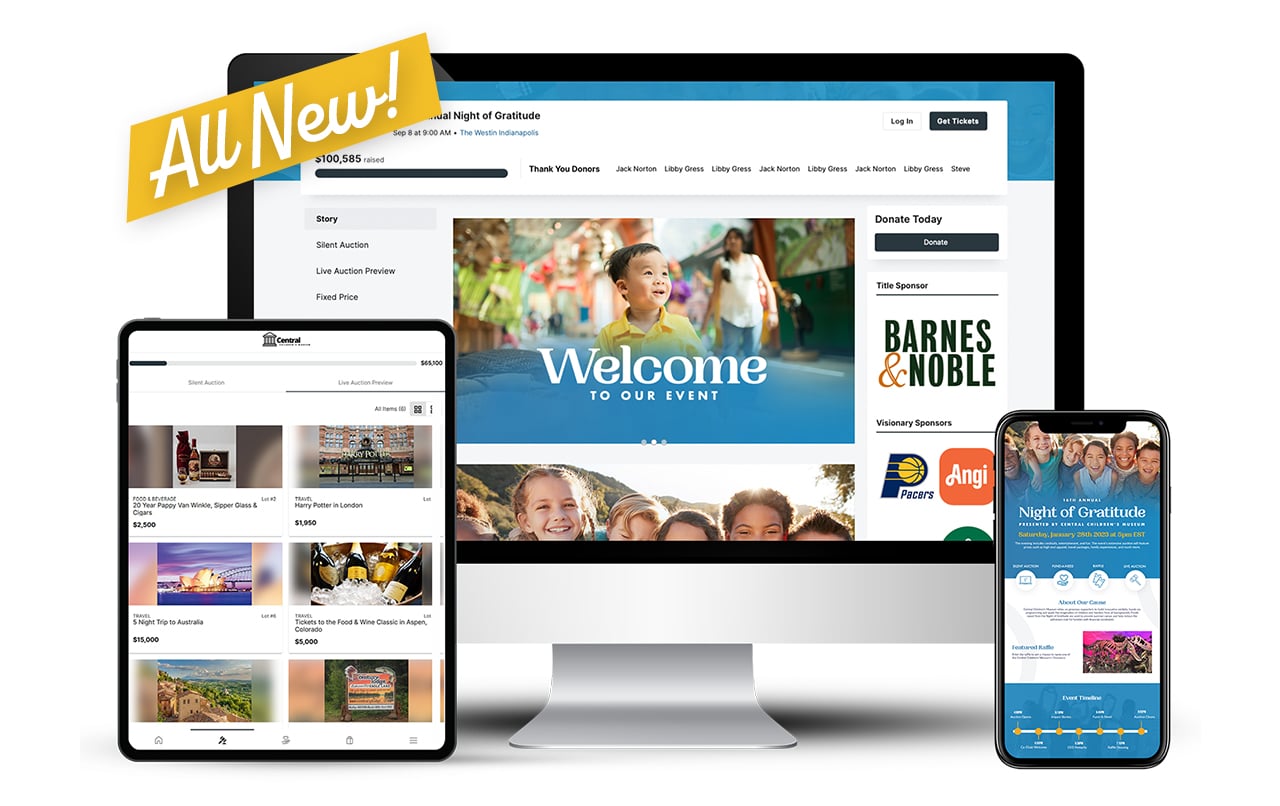
Organizing an Impactful Fundraising Event
Fundraising events are a powerful way to rally your community around your cause and raise significant funds. With a well-thought-out plan, you can see your goals through and move your mission forward in the process.
Eager to learn more about putting together an inspiring fundraising event? Explore these additional resources:
- 23 Phenomenal Fundraising Event Ideas to Skyrocket Giving. Ready to organize a fundraising event? Explore our list of top ideas to maximize giving.
- Unlocking the Secret to Peer-to-Peer Fundraising Success. Peer-to-peer fundraising allows you to leverage your supporters’ networks to increase giving. Learn more in this guide.
- 10 Creative Ideas For Nonprofit Year-End Giving Campaigns. Year-end is a time of heightened giving—and your nonprofit can’t afford to miss out. Discover the top campaigns you can host during this season!




